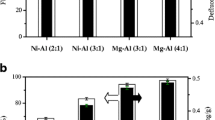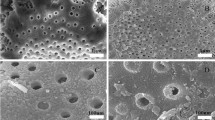Abstract
Fluoride in drinking water is beneficial at low concentrations but is considered harmful for the human health when present at concentrations exceeding 1.5 mg/L. Prevalence of high concentration of fluoride in drinking water, combined with the nonavailability of alternate viable sources, makes the treatment of the contaminated water an essential task. In this study, we report the synthesis and characterization of a hybrid adsorbent; hydroxyapatite-modified activated alumina (HMAA) prepared by dispersing nanoparticles of hydroxyapatite inside activated alumina granules. The composite adsorbent provided a synergy toward fluoride removal from contaminated drinking water. The hybrid adsorbent possesses a maximum adsorption capacity of 14.4 mg F/g which is at least five times higher than the virgin-activated alumina, which has been used extensively for fluoride removal. HMAA was regenerated using six bed volumes of a solution containing commonly available innocuous chemicals. The adsorbent was subjected to multiple numbers of operating cycles within a column, each cycle consisting of one adsorption run followed by regeneration.








Similar content being viewed by others
References
American Public Health Association (APHA) (2012) Standard methods for the examination of water and wastewater. American public health association, American water works association, water environment federation publication. 22nd edition. APHA, Washington D.C
Apparao BV, Meenakshi S, Karthikayan G (1998) Nalgonada technique of defluoridation of water Indian. J Environ Prot 10:292–298
Ayoob S, Gupta AK, Bhat VT (2008) A Conceptual overview on sustainable technologies for the defluoridation of drinking water. Crit Rev Environ Sci Tech 38:401–470
Azbar N, Turkman A (2000) Defluoridation in drinking waters. Water Sci Technol 42:403–407
Chernet T, Trafi Y, Valles V (2002) Mechanism of degradation of the quality of natural water in the lakes region of the Ethiopian rift valley. Water Res 35:2819–2832
Durmaz F, Kara H, Cengeloglu Y, Ersoz M (2005) Fluoride removal by Donnan dialysis with anion exchange membranes. Desalination 177:51–57
Farooqi A, Masuda H, Kusakabe M, Naseem M, Firdous N (2007) Distribution of highly arsenic and fluoride contaminated groundwater from east Punjab, Pakistan and the controlling role of anthropogenic pollutants in the natural hydrological cycle. Geochem J 41:213–234
Gao S, Cui J, Wei ZG (2009) Study on the fluoride adsorption of various apatite materials in aqueous solution. J Fluorine Chem 130:1035–1041
Ghorai S, Pant KK (2004) Investigations on the column performance of fluoride adsorption by activated alumina in a fixed bed. Chem Eng J 98:165–173
Ghorai S, Pant KK (2005) Equilibrium, kinetics and breakthrough studies for adsorption of fluoride on activated alumina. Sep Purif Technol 42:265–271
Hichour M, Persin F, Sandeaux J, Gavach C (2000) Fluoride removal from waters by Donnan dialysis. Sep Purif Technol 18:1–11
Hou D, Wang J, Zhao C, Wang B, Luan Z, Sun X (2010) Fluoride removal from brackish groundwater by direct contact membrane distillation. J Environ Sci 22:1860–1867
Hu K, Dickson JM (2006) Nanofiltration membrane performance on fluoride removal from water. J Membr Sci 279:529–538
Kabay N, Arar O, Samatya S, Yüksel U, Yüksel M (2008) Separation of fluoride from aqueous solution by electrodialysis: effect of process parameters and other ionic species. J Hazard Mater 153:107–113
MacDonald LH, Pathak G, Singer B, Jaffe PR (2011) An integrated approach to address endemic fluorosis in Jharkhand, India. J Water Res Protection 3:457–472
Malaisamy R, Talla-Nwafo A, Jones KL (2011) Polyelectrolyte modification of nanofiltration membrane for selective removal of monovalent anions. Sep Purif Technol 77:367–374
Meenakshi S, Maheshwari RC (2006) Fluoride in drinking water and its removal. J Hazard Mater 137:456–463
Mohapatra M, Anand S, Mishra BK, Giles DE, Singh P (2009) Review of fluoride removal from drinking water. J Environ Manage 91:67–77
Ndiaye PI, Moulin P, Dominguez L, Millet JC, Charbit F (2005) Removal of fluoride from electronic industrial effluent by RO membrane separation. Desalination 173:25–32
Ramos RL, Castillo NAM, Azuara AJ, Barron JM, Rodriguez LEL, Rosales JMM, Pina AA (2008) Fluoride removal from water solution by adsorption on activated alumina prepared from pseudo-boehmite. J Environ Eng Manage 18:301–309
Rao NV, Mohan R, Bhaskaran CS (1998) Studies on defluoridation of water. J Fluorine Chem 41:17–24
Reardon EL, Wang Y (2000) A limestone reactor for fluoride removal from wastewaters. Environ Sci Technol 34:3247–3253
Rehman I, Bonfield W (1997) Characterization of hydroxyapatite and carbonated apatite by photo acoustic FTIR spectroscopy. J Mater Sci Mater Med 8:1–4
Richards LA, Vuachère M, Schäfer AI (2010) Impact of pH on the removal of fluoride, nitrate and boron by nanofiltration/reverse osmosis. Desalination 261:331–337
Saha S (1993) Treatment of aqueous effluent for fluoride removal. Water Res 27:1347–1350
Sahli MA, Annouar A, Tahaikt S, Mountadar M, Soufiane A, Elmidaoui A (2007) Fluoride removal for underground brackish water by adsorption on the natural chitosan and by electrodialysis. Desalination 212:37–45
Sarkar S, Prakash P, SenGupta AK (2010) The donnan membrane principle: opportunities for sustainable engineered processes and materials. Environ Sci Technol 44:1161–1166
Sarkar S, Guibal E, Quignard F, SenGupta AK (2012) Polymer-supported metals and metal oxide nanoparticles: synthesis, characterization, and applications. J Nanoparticle Res 14:715
Singh G, Kumar B, Sen PK, Majumdar J (1999) Removal of fluoride from spent pot liner leachate using ion exchange. Water Environ Res 71:36–42
Stuart BH (2004) Infrared spectroscopy: fundamentals and applications. Wiley, Australia, pp 72–152
Sundaram CS, Viswanathan N, Meenakshi S (2008) Defluoridation chemistry of synthetic hydroxyapatite at nano scale: equilibrium and kinetic studies. J Hazard Mater 155:206–215
Sundaram CS, Viswanathan N, Meenakshi S (2009) Fluoride sorption by nanohydroxyapatite/chitin composite. J Hazard Mater 172:147–151
Wang WY, Li RB, Tan JA, Luo KL, Yang LS, Li HR, Li YH (2002) Adsorption and leaching of fluoride in soils of China. Fluoride 35:122–129
World Health Organization (2008) Guidelines for drinking-water quality: third edition, Incorporating the first and second addenda. 3rd edition, Geneva
Acknowledgments
The second author, A.T., is supported by MHRD, GOI fellowship. Part of the work was supported by the Faculty Initiation Grant received from the corresponding authors Institute. The authors thankfully acknowledge the supports received from these grant and fellowships.
Author information
Authors and Affiliations
Corresponding author
Electronic supplementary material
Below is the link to the electronic supplementary material.
Rights and permissions
About this article
Cite this article
Tomar, G., Thareja, A. & Sarkar, S. Enhanced fluoride removal by hydroxyapatite-modified activated alumina. Int. J. Environ. Sci. Technol. 12, 2809–2818 (2015). https://doi.org/10.1007/s13762-014-0653-5
Received:
Revised:
Accepted:
Published:
Issue Date:
DOI: https://doi.org/10.1007/s13762-014-0653-5




